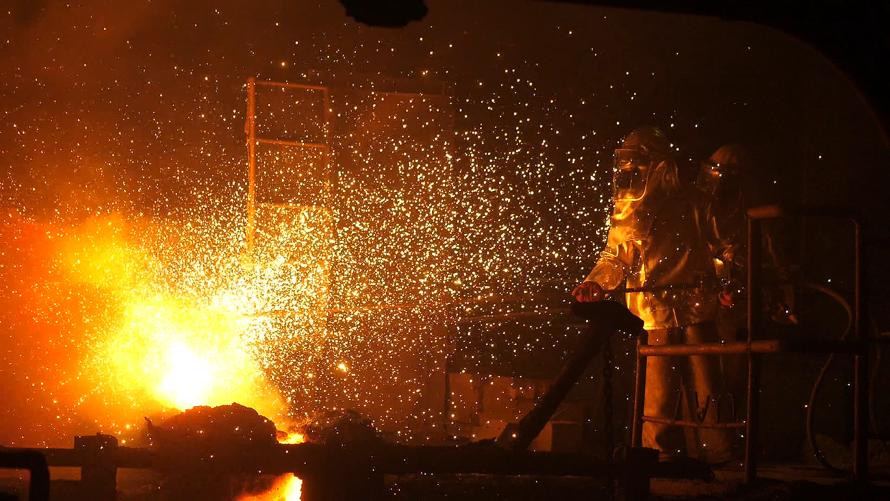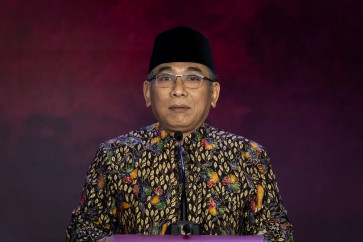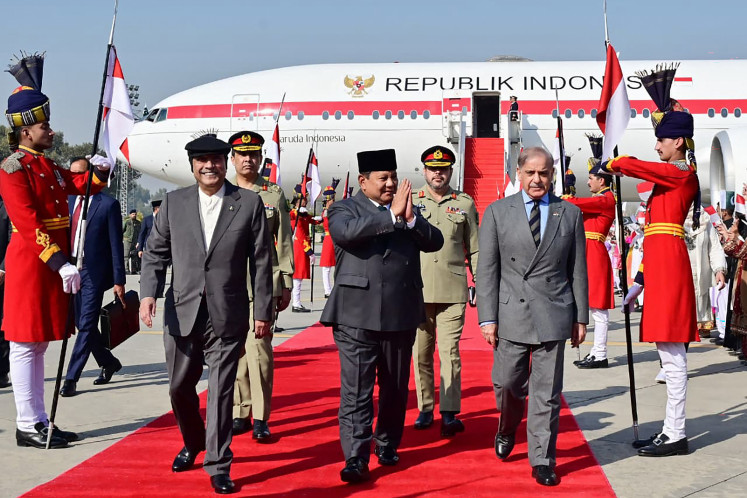Popular Reads
Top Results
Can't find what you're looking for?
View all search resultsPopular Reads
Top Results
Can't find what you're looking for?
View all search resultsOutlook 2021: Govt to push downstream mining industry as coal, metals rebound gently
World Bank data shows that COVID-19 expedited the flattening of coal prices and demand over the decade.
Change text size
Gift Premium Articles
to Anyone
I
ndonesia is poised to spend this year catching up on plans to develop a downstream mining industry as the country races against time to adapt to a long-term global shift in ore demand away from coal towards metals, while prices are expected to rebound gently.
Coal miners plan to continue studying the development of a downstream industry, while metal miners plan to resume their pandemic-delayed metal smelter projects. The latter particularly applies to nickel miners, who were the first to experience a government raw metal export ban.
State-owned mining holding company MIND ID hopes to close several deals early this year related to the formation of a flagship, nickel-rich electric vehicle (EV) battery industry in Indonesia.
“Nickel is expected to become an alternative to the coal industry that has all this time been a major contributor to the mining sector,” said Samuel Sekuritas investment analyst Dessy Lapagu on Nov. 24.
Globally, coal and metal prices are expected to start rebounding this year at a pace reflecting the world’s energy transition. That shift, according to the World Bank’s October 2020 commodity outlook report, has been hampered by the COVID-19 pandemic.
The transition involves a decline in coal-fired power plants and an increase in gas-fired power plants, renewable energy plants and electrification infrastructure such as EVs and power grids, all of which require electrification-related metals such as nickel, copper and aluminum.
World Bank data shows that COVID-19 expedited the flattening of coal prices and demand over the decade. The lender expects prices to rebound from $57.2 per ton last year to $57.8 per ton this year but does not expect them to reach 2019 levels ($77.9 per ton) until 2030 or beyond as countries limit the construction of new coal plants.
Indonesia announced several coal downstreaming incentives last year to shield local coal miners from this long-term demand transition and boost economic growth. The development of a downstream coal industry, an endeavor being spearheaded by state-owned PT Bukit Asam (PTBA), entails converting coal into other chemicals.
The incentives were established by the new Mining Law, the Job Creation Law and the new Nationally Strategic Projects (PSN) list. Regulators plan to issue a government regulation (PP) this year that will detail the terms of these incentives.
Read also: Explainer: Indonesia’s push for coal downstreaming against all odds
“In 20 to 30 years, no one will use coal,” said Bukit Asam president director Arviyan Arifin, acknowledging the urgency of raising the company’s medium-term coal output and investing in coal downstreaming.
Energy and Mineral Resources (ESDM) Ministry data shows 11 downstream coal projects in the pipeline. Seven are coal gasification projects, which convert coal into methanol that can then be processed into fuels, fertilizer, plastics and cooking gas.
Coal will, nevertheless, likely remain an attractive commodity this year as China, the world’s largest coal-buying country, continues its economic recovery, experts have said. Coal is mainly used for electricity generation, and coal plants contribute over half of China’s power.
Mirae Asset Sekuritas Indonesia analyst Hariyanto Wijaya wrote in a note on Dec. 7 that he expected China’s electricity consumption in 2021 and 2022 to outperform that of last year.
“Any improvement in China’s electricity consumption would drive up global coal consumption,” he wrote.
World Bank data shows that the pandemic has pushed down aluminum, copper and nickel prices, although to a much lesser degree than coal. These prices will recover to 2019 levels by 2023 at the latest, the bank suggests, driven by new demand for electrification technologies on top of existing demand, such as for stainless steel, which requires nickel, and for aircrafts, which make use of aluminum.
Mining industry analyst Julian Kettle of consultancy Wood Mackenzie, in a blog interview published on Oct. 30, predicted an “explosion” in demand for the three metals, as well as for cobalt and lithium, over the coming two decades.
He said new demand would be driven specifically by new EVs, charging stations, battery systems, solar panels, wind turbines and power grids.
Indonesia is among the world’s top 15 producers of nickel, copper and bauxite (raw aluminum), but the country is neither a big cobalt or lithium producer, according to the latest United States Geological Survey.
Kettle compared the upcoming demand explosion with the iron boom in early 21st-century China, driven by expansive infrastructure projects. “For some metals, the energy transition could be like the Chinese economic boom on steroids,” he said.
In an effort to capitalize on the transition, Indonesia has banned all nickel ore exports starting on Jan. 1 to force nickel miners to process ore domestically. Indonesia was, prior to the ban, the world’s top producer of nickel ore.
Energy ministry data released on Nov. 10 shows that 31 new metal smelters are slated to begin operation in 2021, 17 of which are nickel smelters. The figure is smaller than the initial expectation of 39 new smelters, including 25 new nickel smelters, following pandemic-induced construction delays.
The Mining Law delayed the washed bauxite and copper anode slime export ban by a year, to 2023, to give miners the financial space to catch up with the delayed smelting projects.
The law promises longer mining permits for metal miners investing in downstream production, and an energy ministry regulation issued in April introduces a floor price for domestically sold metal ore, another incentive for metal miners.
Read also: Govt maintains export ban on nickel, relaxes rules for other metals until 2023
Nickel prices are expected to rise by the second-sharpest degree next year, behind copper, according to the World Bank. Nickel prices dropped from $13,914 per ton in 2019 to $13,500 per ton last year but may rise to $13,800 this year, driven by higher demand and the Indonesian nickel export ban.
Mirae Asset Sekuritas’s Hariyanto echoed the nickel price sentiment, citing “higher demand for steel production, especially from China for its one belt, one road mega project and in anticipation of rising nickel demand for electric vehicle (EV) battery production.”
Indonesia sealed a $9.8 billion deal with South Korea’s LG Energy Solution on Dec. 18 to develop the world’s first integrated electric vehicle (EV) battery industry. The MoU includes strategic investment projects in the EV battery cell industry, which integrates the mining, smelting, refining, precursor and cathode industries, according to an Investment Coordinating Board (BKPM) statement on Dec. 30.
“This investment will make Indonesia the first country in the world to integrate the electric battery industry, from mining to lithium electric car batteries,” BKPM head Bahlil Lahadalia told reporters during a virtual press briefing on Dec. 30. “This is the biggest investment since the [1998] Reform Era and will serve as an opportunity for Indonesia to recover from the coronavirus pandemic.”










